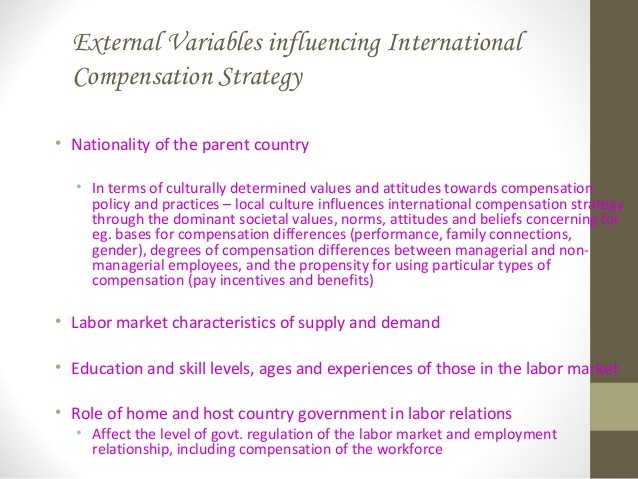Chapter 22 International Remuneration
Post on: 6 Апрель, 2015 No Comment

CHAPTER 22: INTERNATIONAL REMUNERATION
Overview: This textbook chapter examines how to set pay and benefits for expatriates and employees in multiple countries.
Corresponding courses:
INTRODUCTION
A young Compensation Manager was walking around an automobile agency as her car was being serviced. She was looking at the stickers on the new cars. One of the pieces of information struck her forcefully. It told what percentage of the parts that went into the car came from what countries. Around six countries were listed, and the country the car was assembled in constituted around 40% of the parts. Later, while sorting through her clothes, she started noting where they were manufactured. The list included many countries in different parts of the world, but almost none were made in the U.S. What these two observations illustrate is a change in the world economy, called globalization. Products are being produced and sold in worldwide markets, not national markets.
This globalization has come about from two trends. The first is the internationalization of marketing. The revolution in communications has made the demand for goods and services worldwide. This potential worldwide market has been made practical by the increasing standards of living throughout the world. An increasing number of companies now see their marketplace as the world or at least a continent, rather than a country. The second trend has been the drive to reduce the costs of production. Placing production facilities in other countries takes advantage of lower costs, usually lower labor costs. In addition, being closer to the market also provides flexibility to adapt to local needs. 1
The result of both of these trends is that companies now have offices and/or plants all over the world. These facilities need to be staffed and the question becomes, by whom? The choice is either to relocate current employees from another location, involving international transfers, or to hire local people. Staffing an overseas facility can be done using three different groups of people. The first and most obvious are natives of the host country, termed for this purpose, local country nationals (LCN), that is, hiring local Spaniards for an office in Madrid, Spain. A second group would be present employees or new hires from the home country of the company. These people are called expatriates. An accountant working for an American company transferred from St. Louis to Madrid is an expatriate. Lastly, the company could also transfer an accountant from its office in Hong Kong to the new office in Madrid. This person would be called a third country national (TCN). Each of these types of employees requires a compensation program that is different from the home country program, and to a degree, different from each other. 2 This chapter looks at these special compensation programs.
EXPATRIATE COMPENSATION
Companies choose to send current employees to an assignment in another country for a number of reasons. A major reason is that the knowledge and skills needed in the job in the host country are not present in the natives of that country or are in short supply. Another related reason is that the current employee has knowledge of the company that is necessary for coordinating activities in the foreign branch with the home company. A third reason is to provide managers and executives with the kind of development and perspective needed to be an executive in this new global economy. Employees chosen for this reason may be at an early stage of their career or at a later stage when they are being groomed for a high level position. 3
Expatriate assignments may be of a short (less than a year) or longer period of time. Most expatriate assignments from the U.S. are for two to three years. In Japan they are longer, usually five years. Short-term assignments are ordinarily handled as temporary assignments that don’t require a change in pay or benefits. The assignee is given regular pay plus a per diem for living expenses. These per diems can be viewed by going to the ERI’s Relocation Assessor software and clicking on the third tab, Estimated Per Diems. For reasons to be discussed later, short-term assignments are becoming more popular.
Long-term assignments are a different situation. These may represent the most complex compensation programs. Expatriate compensation starts from a presumption that in order to maintain equity and be able to attract employees to take these assignments, you must keep the employee whole. 4 The basic parts of expatriate compensation are like most compensation: base pay, variable pay, and benefits. However, added to this is a series of allowances and tax considerations.
Base Pay
Base pay for the expatriate should start with what the person would be paid for doing the job in the home country. This figure can be arrived at by using one of two methods. The first is to evaluate the job using the company’s job evaluation plan. This may need to be adapted to recognize that the employee will be operating in a foreign environment in which home country supervision is impossible.
The second method is to determine the market worth of the job. This can be done using the ERI Salary Assessor software. The first step is to determine the appropriate job title. This can be done by clicking on the job title in the center of the screen. A screen appears that allows you to type in a proposed title, or you can go to the filter option and type in the probable title to obtain all the possible titles in that area. Once the appropriate job title is determined, click on the Data that Affects Salaries banner. The first of these is location. A decision needs to be made here. The company may choose to send the expatriate from his/her current location or from company headquarters. The former, called home-country based method, relates pay to the expatriate’s home whereas the latter, called headquarters based method, provides a consistency among all expatriates. The other two decisions, company industry and size, can then be recorded. The main screen now has salary figures that can be used to determine the appropriate base salary when the person’s experience and performance level is taken into account. Salary Assessor data is also available for Canada, the U.K. and the E.U.
With the home country based method, base pay can be set if the headquarters based method is used. The second situation, in which the Salary Assessor can be used only if the host country is Canada, the U.K. or E.U. is called the host country based method. This method calls for setting base pay in relation to how the job is paid in the host country. This provides consistency among the workforce in the country but can create major problems in convincing home country employees to accept expatriate assignments to countries that have low wage rates. It also creates problems of repatriation if the host country has high wages. As we shall discuss later, obtaining wage data for countries other than the U.S. is difficult but getting easier as globalization increases. For instance, ERI’S SalariesReview.com ‘s online International Remuneration survey provides wage data for various job titles in 210 countries.
Variable Pay
Variable pay plans for expatriates can be structured similar to domestic programs. A major concern, however, is that the supervisor is far away and may not be fully apprised of the performance of the expatriate. Added to this problem is the fact that goals and performance standards for expatriate assignments are often not carefully spelled out.

Variable pay can be in the form of short-term bonuses or long-term incentives, such as stock options or other devices discussed in chapter 18 on Executive pay. The incidence of variable pay has been rising dramatically in recent years. While expatriates do like variable pay, they tend not to want it to be too much of their total compensation. 5
Bonuses
Besides the performance bonuses of variable pay, it may be necessary to offer a bonus to entice an employee to undertake a foreign assignment. This bonus can take a number of forms. One form is a percentage added to base pay, ranging from 10% to 30% of base pay. 6 The problem with this approach is the expatriates come to see this as a part of base pay; when they are repatriated, this bonus disappears and is seen as a pay cut. A second approach is a lump sum payment at the beginning of the assignment. The advantage of this is that it provides cash to expatriates at a time when their expenses are high. The disadvantage to this approach is that it increases the employee’s income in one year and may raise his or her tax rate. A third approach that tries to work between the first two is to have a schedule of bonus payments, clearly separated from base pay. These payments are weighted to the beginning of the assignment and then distributed before the expatriate is brought back home.
Allowances
The major difference between domestic pay practices and expatriate pay programs is the addition of allowances. Transferring an employee overseas is expensive. It involves the movement of a whole household of goods, the employee and family. The employee and family then arrive in a country where they are unfamiliar with the culture and customs. They must establish all the connections that a family needs in these unfamiliar surroundings.
Company assistance programs may include language training and a course in the local culture and customs. After arrival, employees also need help in finding adequate housing, schools, shopping areas, medical facilities, and a host of other things that a move to a new area entails.
Cost-of-living allowance. In order to keep the employee whole, the living standard of the expatriate needs to be retained. Bringing a standard of living up to American norms in a foreign country is usually very expensive. Figure 22-1 illustrates some of these differences. In order to retain their standard of living. the expatriate is given an allowance so that the family may live as closely as possible to how they would live in the U.S. This allowance is a percentage of base pay. It is calculated based upon the difference in the cost of living between the host country and the expatriate’s hometown or headquarters.
This cost of living differential can be obtained from a number of sources. ERI’s Relocation Assessor database is one such source. The main screen allows one to compare living costs between over 8,000 cities worldwide. The percentage difference can then be applied to the base pay in order to determine the appropriate allowance. Cost-of-living information may also be obtained at SalariesReview.com. Finally, a useful government site that provides information on overseas costs is. www.state.gov/www/perdiems/quarterly_reports/index.html.
Cost-of-Living Differentials Between Chicago and International Cities














